You are using an out of date browser. It may not display this or other websites correctly.
You should upgrade or use an alternative browser.
You should upgrade or use an alternative browser.
Converting an in-ground pool to a garden pond
- Thread starter Timothy
- Start date
- Joined
- Mar 20, 2011
- Messages
- 7,257
- Reaction score
- 4,819
- Location
- near Effingham, Illinois
- Hardiness Zone
- 5b
So it's burlap that gives the "natural" look to your islands. Clever indeed! Can't wait to see the bog.
- Joined
- Apr 27, 2015
- Messages
- 449
- Reaction score
- 717
- Location
- Southern Maine
- Hardiness Zone
- 5
- Country

So it's burlap that gives the "natural" look to your islands. Clever indeed! Can't wait to see the bog.
Thank you. If the burlap is over-sized a couple of inches it hangs down into the water and the edges get pretty frazzled. This gives a hiding place and some protection from predators. It also wicks water up to the bottom of whatever pots are sitting on the island. Frogs like it because it's damp, but still open. A couple of hot sunny days last summer I was looking for the fish and could only see a few. Searching for the rest I discovered them all sheltered under the shade of the two islands. I have allowed them to float free and have anchored them. I prefer the anchors because it keeps them out of harm's way.
tbendl
T
- Joined
- Jul 14, 2014
- Messages
- 4,393
- Reaction score
- 4,222
- Location
- Gulf Coast-Mississippi 8b
- Showcase(s):
- 1
Hmmm I like the floating island, I wonder if I could incorporate that into my pond, I would be able to get rid of some of the stands I have in the pond. It looks wonderful.
- Joined
- Apr 27, 2015
- Messages
- 449
- Reaction score
- 717
- Location
- Southern Maine
- Hardiness Zone
- 5
- Country

Hmmm I like the floating island, I wonder if I could incorporate that into my pond, I would be able to get rid of some of the stands I have in the pond. It looks wonderful.
Just off hand, I would say if you have room for stands, you have room for an island or two. Another advantage of the islands is you can put two or three different plants on/in it and perhaps even conserve some space.
tbendl
T
- Joined
- Jul 14, 2014
- Messages
- 4,393
- Reaction score
- 4,222
- Location
- Gulf Coast-Mississippi 8b
- Showcase(s):
- 1
- Joined
- Apr 27, 2015
- Messages
- 449
- Reaction score
- 717
- Location
- Southern Maine
- Hardiness Zone
- 5
- Country

I have seen where they plant impatiens on them. @pecan has or had an amazing floating island. You used the blue and she liked the pink. Any idea what the difference is?
Not really, I suspect it's just what's available in your area. The key is "closed cell" which won't soak up water. Maybe it's a subtle gender thing..............
tbendl
T
- Joined
- Jul 14, 2014
- Messages
- 4,393
- Reaction score
- 4,222
- Location
- Gulf Coast-Mississippi 8b
- Showcase(s):
- 1
LOL 

- Joined
- Apr 27, 2015
- Messages
- 449
- Reaction score
- 717
- Location
- Southern Maine
- Hardiness Zone
- 5
- Country

Alas! The last chapter in this already too long story. It is actually ya'll's fault you know. If you ask an old man about his grand kids, his dog, his old truck, or his hobby, be prepared to hear more than you wanted to know!
In the photos of the re-construction you saw the old pool skimmer box, and the pool return outlets. They were a mistake. Once everything was said and done and the new water was pumped in via the truck, I learned in a day or two I had a slow leak. I ended up tracing it to the skimmer box and decided to completely abandon any pool related equipment. I made a plate to bolt onto the skimmer box, cut an over-sized piece of EPDM, and used some of that evil black goop in a tube to seal the skimmer closed. After putting some tape on the return plugs, they got sealed too. Since then and with no piercings of the liner anywhere (not even a BD) the water level has remained constant save for the natural evaporation.
So, having thought about the bog last summer into fall, I decided to build it parallel to the "dock" above ground. This would allow gravity flow back to the pond, a minimum of piping to the supply side, and create a sort of subtle boundary to that side of the pond.
The downside was all of the established plants alongside the "dock" would have to be moved, and it was getting chilly so I had to get a move on. First thing was to move the plants. After that it was flip a coin for how big this bog would be. Proportion-wise, 20'X4'X 2' looked pretty good, so.... 50' of ground contact PT 4 X 4's for a footer, 6 - PT 2"X 8" X 16' for the sides and ends, 50' of PT 2"X 6" for the cap, 3 sticks (8' ea.) of 5/8" rebar, and 4- 8' PT 2X4's.
The first critical aspect of this project was making sure the 4X's were level. I had to build up a little on one end and scalp a little on the other end. After laying out the 4X's, and cutting and placing the ends, I positioned all the pieces and double checked the levelness. Using an adjustable auger bit set to just slightly over 5/8" bored holes through the 4X's then drove pieces of rebar through the holes to anchor the "footers". Next was laying the first "course" of 2" X 8" on edge. These were placed such that the inside was flush with the inside of the 4X. This did two things...provided a smooth interior for the 2X4 supports, and gave a "finished edge" outside of the box on the bottom.
After the first "course" was temporarily set up, four holes were dug 2' deep down each side for the 2X4 support pieces. One in each corner, one in the middle of the 16' section on the bottom which coincides with the joint on the upper course. (16' + 4' to equal the 20' run two times on each side, staggering the joints.)
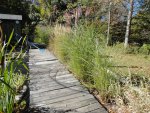

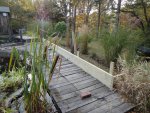
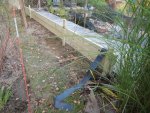
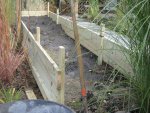
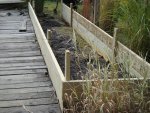
I then laid in an old worn out plastic tarp, and shoveled - wheel barrowed in two yards of granite dust (sand) into the corners and bottom outside edges to provide a bed for the liner. Laid in the liner and tack-nailed the top edges in several places then filled it with pond water. The nailing was done to determine if there were any stress wrinkles in the liner. None appeared, so I thought I'd play a little.
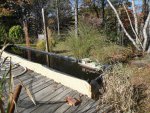
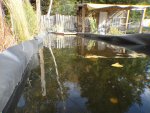
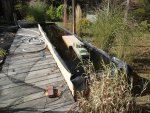
I had calculated the water volume in the bog and ordered 2 1/2 yards of pea gravel to fill it up. While that was coming the supply line and return line was put in. By this time the weather was getting pretty chilly, and it was time to quit for the year. I cut the cap pieces, fastened them on with a couple of screws, and created a "green house" cover for the entire thing for an experiment which didn't work out because of the severe winter we had, but at least the bog was ready to test in the spring.
!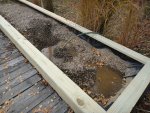
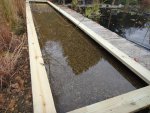
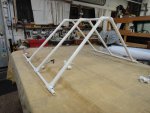
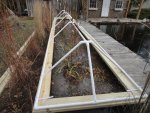
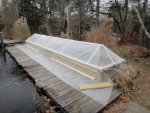
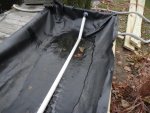
After a too long winter I was getting anxious to try this bog out. I ran some water through the system and got the "dust" washed off the pea gravel, but had used the hose and diverted that part to the yard. Once the water ran fairly clean the return was set back to the pond. One thing I discovered here was, the hose return would be a bad idea in our circumstance. One twig, and a couple of leaves would allow the bog to over flow and if not tended to quickly cause a problem. My solution was to build a box that protruded into the end of the bog to create a catch basin for anything that might otherwise clog the return. From this box, it's a free fall into a sluice box then back to the pond. With this arrangement it's almost impossible for the bog to back up.
As you can see in these last few photos, the return isn't quite finished, I have some finessing and cleaning up to do, but that's about it.
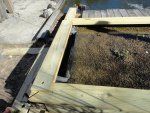
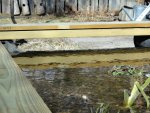
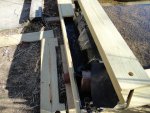
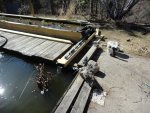
That's my story, and I'm sticking to it! Thanks for your patience!
In the photos of the re-construction you saw the old pool skimmer box, and the pool return outlets. They were a mistake. Once everything was said and done and the new water was pumped in via the truck, I learned in a day or two I had a slow leak. I ended up tracing it to the skimmer box and decided to completely abandon any pool related equipment. I made a plate to bolt onto the skimmer box, cut an over-sized piece of EPDM, and used some of that evil black goop in a tube to seal the skimmer closed. After putting some tape on the return plugs, they got sealed too. Since then and with no piercings of the liner anywhere (not even a BD) the water level has remained constant save for the natural evaporation.
So, having thought about the bog last summer into fall, I decided to build it parallel to the "dock" above ground. This would allow gravity flow back to the pond, a minimum of piping to the supply side, and create a sort of subtle boundary to that side of the pond.
The downside was all of the established plants alongside the "dock" would have to be moved, and it was getting chilly so I had to get a move on. First thing was to move the plants. After that it was flip a coin for how big this bog would be. Proportion-wise, 20'X4'X 2' looked pretty good, so.... 50' of ground contact PT 4 X 4's for a footer, 6 - PT 2"X 8" X 16' for the sides and ends, 50' of PT 2"X 6" for the cap, 3 sticks (8' ea.) of 5/8" rebar, and 4- 8' PT 2X4's.
The first critical aspect of this project was making sure the 4X's were level. I had to build up a little on one end and scalp a little on the other end. After laying out the 4X's, and cutting and placing the ends, I positioned all the pieces and double checked the levelness. Using an adjustable auger bit set to just slightly over 5/8" bored holes through the 4X's then drove pieces of rebar through the holes to anchor the "footers". Next was laying the first "course" of 2" X 8" on edge. These were placed such that the inside was flush with the inside of the 4X. This did two things...provided a smooth interior for the 2X4 supports, and gave a "finished edge" outside of the box on the bottom.
After the first "course" was temporarily set up, four holes were dug 2' deep down each side for the 2X4 support pieces. One in each corner, one in the middle of the 16' section on the bottom which coincides with the joint on the upper course. (16' + 4' to equal the 20' run two times on each side, staggering the joints.)






I then laid in an old worn out plastic tarp, and shoveled - wheel barrowed in two yards of granite dust (sand) into the corners and bottom outside edges to provide a bed for the liner. Laid in the liner and tack-nailed the top edges in several places then filled it with pond water. The nailing was done to determine if there were any stress wrinkles in the liner. None appeared, so I thought I'd play a little.



I had calculated the water volume in the bog and ordered 2 1/2 yards of pea gravel to fill it up. While that was coming the supply line and return line was put in. By this time the weather was getting pretty chilly, and it was time to quit for the year. I cut the cap pieces, fastened them on with a couple of screws, and created a "green house" cover for the entire thing for an experiment which didn't work out because of the severe winter we had, but at least the bog was ready to test in the spring.
!






After a too long winter I was getting anxious to try this bog out. I ran some water through the system and got the "dust" washed off the pea gravel, but had used the hose and diverted that part to the yard. Once the water ran fairly clean the return was set back to the pond. One thing I discovered here was, the hose return would be a bad idea in our circumstance. One twig, and a couple of leaves would allow the bog to over flow and if not tended to quickly cause a problem. My solution was to build a box that protruded into the end of the bog to create a catch basin for anything that might otherwise clog the return. From this box, it's a free fall into a sluice box then back to the pond. With this arrangement it's almost impossible for the bog to back up.
As you can see in these last few photos, the return isn't quite finished, I have some finessing and cleaning up to do, but that's about it.




That's my story, and I'm sticking to it! Thanks for your patience!
Attachments
Last edited:
- Joined
- Jun 22, 2011
- Messages
- 4,684
- Reaction score
- 3,764
- Hardiness Zone
- 5b
- Country

nice looking pond, great story and you told it well too. I think you've earned a summer off, ya know? Sort of do that sit back and admire the view with something liquid in a glass.
Heh, that is until you realize your pond is too small (even with as large as it is, too! Hits us all...)
Michael
Heh, that is until you realize your pond is too small (even with as large as it is, too! Hits us all...)
Michael
- Joined
- Apr 27, 2015
- Messages
- 449
- Reaction score
- 717
- Location
- Southern Maine
- Hardiness Zone
- 5
- Country

nice looking pond, great story and you told it well too. I think you've earned a summer off, ya know? Sort of do that sit back and admire the view with something liquid in a glass.
Heh, that is until you realize your pond is too small (even with as large as it is, too! Hits us all...)
Michael
Thank you Michael.
I think you're right......a little Flor de Cana on some crushed ice, in the shade, and watch the microcosm unfold. It was/is on my list to enhance the waterfall to a several tiered system with grottoes for flower pots with ferns and vines, but it's too early for any of it right now. I'd be happy if we could just string three days of sunshine together!
- Joined
- Jun 23, 2010
- Messages
- 45,013
- Reaction score
- 30,057
- Location
- Frederick, Maryland
- Showcase(s):
- 1
- Hardiness Zone
- 6b
- Country

So did your bog help your pond? once you got it running?
Love the build story.
Love the build story.
I too did not find the story too long. I enjoyed it. Would love to know how the bog is working for you. If it helps your water clarity. Great place to grow plants.
A bog is on my to do list as well.
A bog is on my to do list as well.
- Joined
- Apr 27, 2015
- Messages
- 449
- Reaction score
- 717
- Location
- Southern Maine
- Hardiness Zone
- 5
- Country

Love the results and love the story!
Thank you Cas. Although I'm a newbe too, Welcome aboard!
So did your bog help your pond? once you got it running?
Love the build story.
LOL Gotcha Addy!
I can't say enough about the difference. I started it up nine days ago and the water is just as clear now as the day it was put in. I found three pots that had gone missing. I'll use an underwater camera tomorrow and see if I can get some good photos. I wouldn't be surprised if the visibility was the whole length of the pond. Amazing.
Ask a Question
Want to reply to this thread or ask your own question?
You'll need to choose a username for the site, which only take a couple of moments. After that, you can post your question and our members will help you out.
Similar Threads
Forum statistics
Latest Threads
-
Pond Sweeper
- Started by Marietta Ray
-
Help!!
- Started by Hansen54
-
Fierce fountain/waterfall
- Started by Mollieanna
-
Hello from new member
- Started by Mollieanna
-
Hello from down under
- Started by marcinau
-
Plants
- Started by rrebeccag
-
Summer vacation
- Started by dsmith8550
-
Problem with DIY forum
- Started by mrsclem
-
DIY pond
- Started by WD47D

